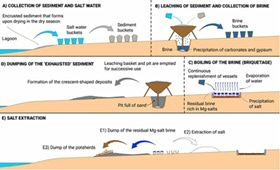Research question
Control of the salterns in the Tiber delta was important for Rome’s rise to power, however, physical evidence is lacking. Our questions are: When were salterns first established and how was salt produced before their installation? How did people keep up with the increasing demand for salt by the rising population of the early states in Central Italy, in particular Rome, and how was it secured? We will investigate these questions with an up-to-date methodology to contribute with a historically important case study to the global archaeological and anthropological debate on salt-making and resource control in the context of prehistoric and early state societies. We focus on detecting scale increase in the production of salt that, we assume occurred in Central Italy in the formative phase of the city-states between the Final Bronze to Early Iron Age around 1000 BCE. Recently, the applicant and his team discovered the origins and chaîne opératoire of two early salt production sites at two sites along the Tyrrhenian coast. In the Pontine plain, south of Rome, the team investigated a Bronze Age settlement in the Caprolace lagoon (Alessandri et al., 2019) revealing its involvement in salt production. Evidence consisted of remains of an industry known as briquetage. This implies preparing and boiling a solution of seawater in special reddish ceramic jars to obtain solid salt, as described in ethnographical sources and archaeologically attested in prehistoric contexts elsewhere in Europe (Harding, 2013; Weller and Brigand, 2015). Jars had to be broken to extract salt, hence briquetage sites have huge potsherd dumps. The Caprolace ceramic evidence suggests that salt production was linked to food conservation (probably fish) and that salt and salted commodities were traded and consumed inland. In the Final Bronze Age/Iron Age Puntone site, in Tuscany, the team recovered similar evidence and reconstructed the chaîne opératoire (Sevink et al., 2020).
Understanding salt production techniques gives insight in labour organization, time investment and thus scale of production, which can be linked to contemporary settlement organization. Our reconstruction was achieved by combining geophysical techniques, archaeological excavations, functional artefact study and chemical analyses of soils and artefacts. This novel methodology now allows us to explore ethnographically known protohistoric briquetage and, importantly, detect historically known salt production in salterns, a more efficient production mode using series of ponds for salt precipitation that arose in the context of early urbanization. Understanding this transition from relatively small-scale and labour-intensive briquetage to large scale production in salterns is at the heart of our research into scale increase and state control of salt production during early state formation.

